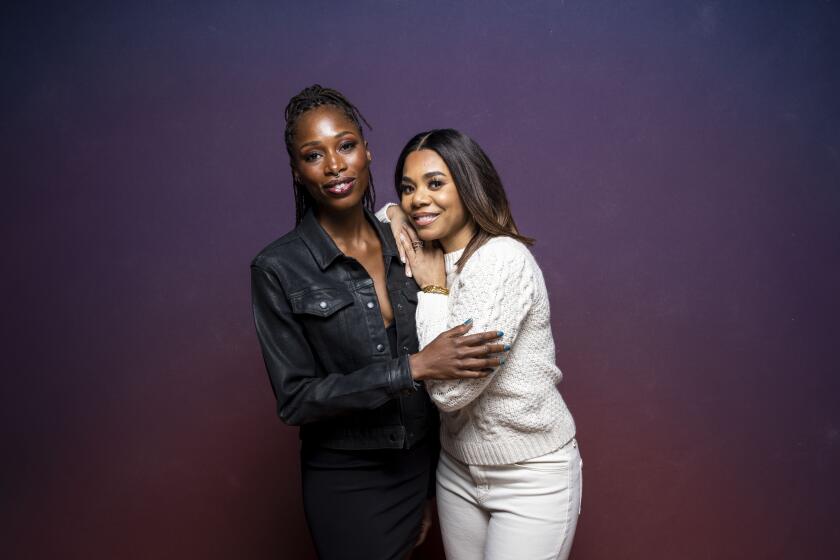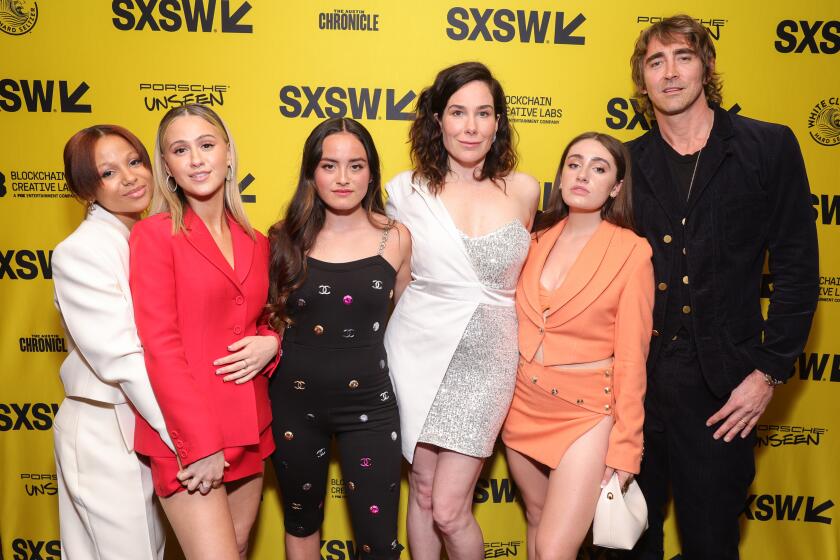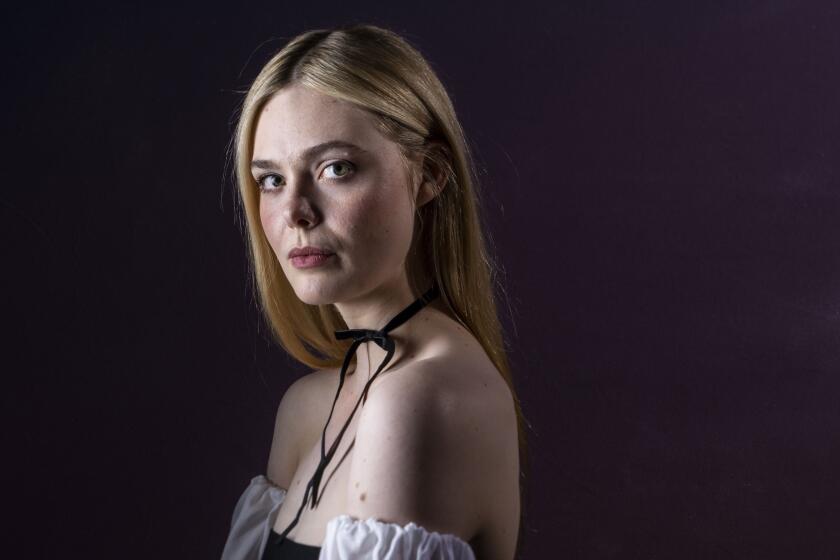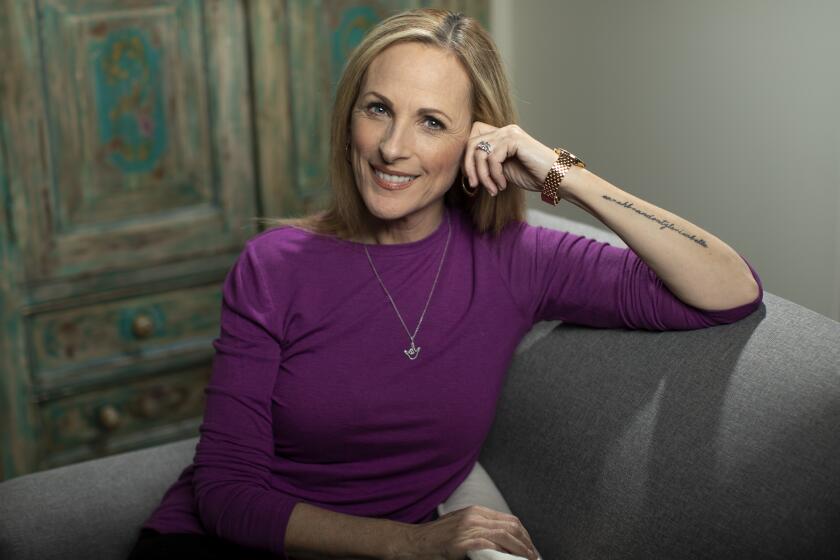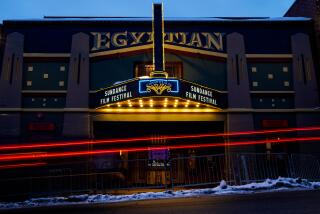Sundance from home: A virtual wrap on 2021’s unprecedented all-digital festival
- Share via
This year’s Sundance Film Festival, its first virtual incarnation, ran Jan. 28 to Feb. 3 and Times film staffers were collectively glued to our TVs, laptops, smartphones and other devices to join in the annual celebration of independent cinema. Critic Justin Chang and reporters Mark Olsen and Jen Yamato discuss a most unusual festival experience and nod to some standout films and a few rather puzzling decisions by the festival’s awards juries.
JUSTIN CHANG: At a normal Sundance Film Festival, Jen and Mark, we wouldn’t be writing to each other. We’d be sitting around that big kitchen in the L.A. Times condo, snacking on pizza and gummy bears, exchanging quick notes on the movies we’ve seen and strategizing about what to see and write about next. Then some of us would don our beanies and parkas and head out into the snow while doing the kinds of quick travel-time calculations — to walk, shuttle or rideshare? — that are crucial to getting around Park City, Utah, during the busiest 10 days of the film year.
What a difference a pandemic makes: This year’s Sundance ran only seven days and screened significantly fewer movies than usual. Under the tightened circumstances, I’m impressed by how many good ones I’ve managed to see. And while Sundance 2021 was hardly the first festival to go virtual in the COVID era, it might be the one that feels most diminished as a result, the most antithetical to the real deal. Slipping on black ice, piling into sardine-can shuttles and subsisting on a diet of theater concessions are not the easiest experiences to import into your living room (though if someone has the recipe for that awesome chili they serve at the Library, I’d be down for whipping up a vat).
A lot of the grumbling and inconvenience has been eliminated, in other words, but so has a lot of the fun. All of which is to say, I miss you both and our entire Times film team — something that’s been true for these past 10 months but especially this week of all weeks.
MARK OLSEN: A group of movie journalists sharing a house for the better part of a week might sound like the stuff of a dodgy reality-show pilot, but it has always been a most pleasant experience. And it must be said I was sort of dreading the idea of our first Sundance since critic Kenneth Turan retired. Always such a guiding light for our festival coverage, he genuinely wrote the book on Sundance. So maybe it was OK just this once to take a break from Park City.
While other festivals have mounted virtual editions, this version of Sundance — the first under new festival director Tabitha Jackson — seems to have cracked the code on how to balance the competing demands of at-home convenience and you-are-there excitement. I have been very pleasantly surprised by how energized and engaged I have been, even when I am just logging onto my computer as I have done basically every day for almost a year now. Whether it has been the ticketing and scheduling system, the prescreening introductions and postscreening Q&As or the ease of accessing additional talks, I have fallen into the rhythms of this virtual festival far more fully than I did other virtual events. While all this has certainly not replaced the real-world, in-person experience, festival organizers quite smartly were not particularly aiming to do so, rather coming up with something else, something that feels by definition new.
A wide range of narrative and documentaries highlights to watch for at the first virtual Sundance Film Festival.
JEN YAMATO: You’re both right! There’s no substitute for the energy of being there with your ear to the ground, delirious from the altitude and lack of sleep, subsisting on concession-stand hot dogs and pocket snacks — film critics lead a glamorous gastronomical festival life, you know — and emerging from the dark totally energized by the discovery of great new films and voices. Yet at a time when it can be hard to muster the motivation to put on pants for a Zoom meeting, the virtual experience of streaming movies and filmmaker Q&As was shockingly easy. And, maybe more important, actually inviting.
I found myself popping into the New Frontiers portal, designed like a soothing New Age-y international space station, between films. There you could browse augmented reality installations while running around in your own 3-D avatars, sidle up to a virtual bar and chat up strangers (or studiously avoid eye contact while glancing around for people you know) and yes, even find weird virtual karaoke with friends from across the world. All of which at times hilariously approximated the experience of being at Sundance IRL, minus the lobby hot-take huddles and the constant anxiety of slipping on ice and falling awkwardly in front of gawking ski-season tourists just trying to walk up and down Main Street.
Speaking of those hot-take huddles: Fire up a pot of virtual chili and let’s get into the films. What stood out to you this Sundance?
CHANG: I still have a few more U.S. dramatic competition titles to watch, but the standout of the section for me so far is “Passing,” Rebecca Hall’s exquisite debut feature about the friendship between two 1920s Black women, one of whom is passing herself off as white. That description didn’t prepare me for all the subtle complexities of identity — with regard to class and sexuality as well as race — that Hall taps into here, and with a delicacy and inherent feel for the medium that put many more experienced filmmakers to shame. It also features a trio of superb performances from Tessa Thompson, Ruth Negga and Andre Holland.
“Passing” was beautifully shot in black-and-white, and so was the World Cinema dramatic entry “The Dog Who Wouldn’t Be Quiet,” a movie to which it bears no other resemblance. Really, this latest from Argentine filmmaker Ana Katz bears no resemblance to anything I’ve seen recently: It’s the story of a young man and his dog, it’s a meditation on the passage of time (real and cinematic), and at one point it becomes a meteorological crisis drama that brushes up — fascinatingly, not exploitatively — with our own global health crisis. Oh, and at 73 minutes, it’s one of the shortest features I’ve seen this Sundance and one that’s possibly stayed with me the longest.
I’ll also join the chorus of praise for “Summer of Soul ( … Or, When the Revolution Could Not Be Televised),” Ahmir “Questlove” Thompson’s exuberant treasure trove of a documentary about the 1969 Harlem Cultural Festival. Made with footage triumphantly excavated after sitting in a basement for nearly 50 years, the movie premiered on the first day of Sundance, following what seems to me an interesting recent pattern among major virtual festivals: New York kicked off with “Lovers Rock,” and Toronto led with “David Byrne’s American Utopia.” The message seems clear: We miss live music, we miss crowds, we miss transcendent communal experiences. These movies give us a taste of that, and maybe even a promise that we’ll get there again.
Actresses Tessa Thompson and Ruth Negga collaborate with Rebecca Hall on her adaptation of Nella Larsen’s acclaimed novella ‘Passing.’
OLSEN: Justin, let me second your support of “Summer of Soul,” perhaps the most straight-up joyful movie I saw at the festival. I found this year that many of the films that most grabbed me were also ones I couldn’t fully let go of, raising feelings I couldn’t quite grasp. But they were titles I am somewhat desperate to see again, to reexamine and unravel.
And that would very much include “Passing,” a movie that has a deceptive stillness, masking the roiling emotions and multiple issues that it grapples with. I am eager to see what its life is after the festival.
I feel the same way about “Judas and the Black Messiah,” directed by Shaka King, which tells the story of slain 1960s civil rights activist Fred Hampton through the eyes of William O’Neal, the FBI informant who would betray him. The movie has a stirring, powerfully charismatic performance by Daniel Kaluuya as Hampton but also a moody, interior and conflicted turn by LaKeith Stanfield as O’Neal. Their mix of energies gives the movie a complicated, enigmatic quality that begs to be reengaged with and considered further.
Somehow it slipped by me that the festival was premiering “In the Earth,” a new folk-horror freak-out from British director Ben Wheatley, until I saw people chattering about it online. I am so glad I was able to catch up with it. The film’s story of isolation, science, nature and madness captured this destabilizing moment we are all struggling to make sense of, with performances by Joel Fry and Ellora Torchia that mix terror, humor and resilience.
Oscar winner Marlee Matlin returns to the big screen in the Sundance Film Festival opener “CODA,” and she can’t wait for people to see it.
YAMATO: The beautiful thing about film festivals, even virtual ones, is that even if you miss the priciest big-money sales titles or the award-sweeping winners of the fest, treasures are to be found throughout the program.
Another upside to Sundancing virtually from your own couch: There’s no one to see you weeping uncontrollably when the lights come up, as I did during Christopher Makoto Yogi’s lyrical and melancholic Hawaiian ghost tale “I Was a Simple Man.” Steve Iwamoto, in his feature debut, plays the elderly Masao, who lives alone on Oahu and is dying. He is alone and yet not alone: Family members, the ghost of his late wife (Constance Wu) and his own fractured memories visit him in time-shifting, end-of-life reveries. Watch it at the right time in your own life and it’ll be hard not to let this one soak into your soul.
I also was struck by how resonantly other very, very different performances stayed with me. Most audacious of them all, by a mile: the nuanced and daring turn by first-time actress Sofia Kappel that anchors Swedish filmmaker Ninja Thyberg’s debut feature, “Pleasure,” a graphic, transgressive tale probing issues of agency and consent, about a young woman navigating her way through L.A.’s adult-entertainment industry.
But the two performances I still can’t shake are the haunting turns Michael Greyeyes and Chaske Spencer contribute to “Wild Indian,” a boldly assured first feature from writer-director Lyle Mitchell Corbine Jr. The actors star as Makwa and Ted-O, estranged Anishinaabe men linked by a terrible act of violence from their childhood who collide, years later, after taking opposite paths in life. It’s a plum role for Greyeyes, who builds a chilling portrayal at the crossroads of history, rage and trauma. Spencer, meanwhile, is simply devastating as the tortured Ted-O, delivering one of the finest performances of the fest.
CHANG: I’m with you on Greyeyes and Spencer, Jen, and without divulging any of the surprising directions “Wild Indian” takes, I’ll just say that because of the movie’s particular narrative choices, it’s no easy feat for those actors to convince us of their shared emotional history — but convince us they do, unnervingly so. I’d have liked to see Corbine’s tense, tightly wound film earn some recognition from the U.S. dramatic competition jury, which gave a whopping three prizes (for grand jury prize, director and ensemble) to Sian Heder’s “CODA,” which also took the section’s audience award prize.
In my 15 years of attending Sundance, I’ve never seen a single movie sweep the awards so decisively (and walk away with a $25 million distribution deal). And as much as I like “CODA” myself — and as wary as I am of criticizing jury decisions, knowing full well how difficult they can be — the love for that movie, in this instance, can’t help but feel ungenerous to the other strong films in the competition, even if it was a more pared-down selection than usual. I was at least glad to see an acting award for the perpetually underrated Clifton Collins Jr. in “Jockey,” a stirring end-of-the-race-course drama that takes us into a world its writer-director, Clint Bentley, clearly knows in his bones.
Other award winners to which I tip my virtual beanie in admiration: Jesmark Scicluna’s actor prize for the World Cinema dramatic entry “Luzzu,” the first Maltese film ever to screen at the festival. The World Cinema documentary grand jury prize for “Flee,” Jonas Poher Rasmussen’s heartbreaking, beautifully animated film about an Afghanistan-born refugee and his harrowing search for a place to call home. And speaking of animation, I was pleased to see Dash Shaw win an Innovator Award in the festival’s Next section for his darkly beguiling fantasy “Cryptozoo,” which could well have been titled “X-Menagerie”: It’s got a unicorn and a gorgon and a kraken and even a “Shape of Water”-esque cross-species sex scene. It’s not the kind of thing you see every day, or every Sundance.
As a 20-something woman who becomes a gestational surrogate for a 40-something single man, Patti Harrison breaks new ground with an unexpected change from her absurd, sardonic stand-up comedy.
OLSEN: I agree that the topline awards narrowed the view of the festival in ways I was personally dismayed by, given how there was still something expansive and exploratory even within the more focused and scaled-back program. The shortened calendar for the festival really snuck up on me when I realized I had more than a dozen films I still wanted to see and not much time left to fit them in.
While many of the films I saw before the festival, such as “El Planeta” and “Together Together,” remained strong in my mind, there were more discoveries along the way. I also was charmed by the psychedelic fantasia of “Cryptozoo,” which was one of many films along with “Mayday,” “Strawberry Mansion” and others that took a needed break from strict reality, as if filmmakers were trying to get away by going out of their heads.
I heard from friends around the country who were watching films online that under normal circumstances they wouldn’t have access to without traveling to Park City. So I suppose the challenge moving forward will be how does the festival somehow combine the best of both worlds, whether it is possible to provide the sort of broad accessibility and expanded participation this virtual event provided while also getting back to the more directly communal experience of the in-person event. Hopefully by 2022 we will be in a place to find out.
YAMATO: Yes, but I can’t help but wonder what the selection field will even look like by the time we come back around to Sundance: As Tabitha Jackson noted on the eve of this pared-down iteration, there will likely be less for programmers to pick from, given how widely the pandemic has shut down the film industry. If you thought there were a ton of movies about isolation told through screens this year, what in the world are we going to see from lockdown auteurs in 2022?
I’m a bit surprised to say that I now find myself more up for going deeper into virtual spaces and hope other major festivals find ways to follow suit. Getting to transport my brain into so many different worlds and storyscapes with my cat sitting next to me on the couch was such a welcome escape from, well — *gestures at everything* — and if Sundance just set a bar for how to go virtual, it’s exciting to think about how others might put their own stamps on a similar experience.
Maybe it also forced a necessary reset. No being shut out of oversold screenings, no freezing in the cold waiting for shuttles, no irritating chatterboxes broadcasting spoiler-y opinions in the lobby after the first screening of a hot-ticket title. (I’d say no influencers crowding into branded lounges but there were enterprising companies that managed to dole out swag — even at a virtual festival.) The fact that geography and access were not as limiting factors this year feels like a welcome democratization for festival culture in general, one I’ll be curious to see bear out as we move forward into the future.
More to Read
Only good movies
Get the Indie Focus newsletter, Mark Olsen's weekly guide to the world of cinema.
You may occasionally receive promotional content from the Los Angeles Times.
